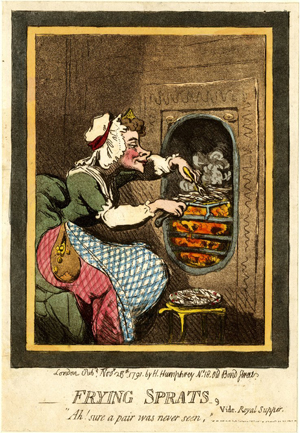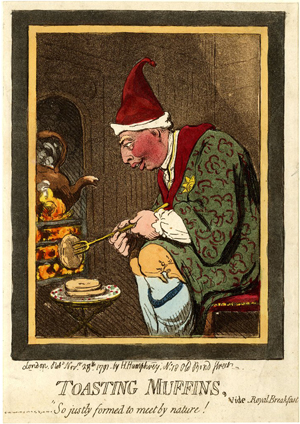Frying Sprats | Toasting Muffins
In the official portraiture of Britain in the 18th century, paintings of husbands and wives were not uncommon. And even though these were usually commissioned portraits, there was a growing informality in the portraits that resulted (since Hogarth) from the influence of the conversation piece.
Sometimes the husband and wife were painted in separate but companion portraits, intended to be hung and seen together. They were then designed to face one another—one looking right, the other left— and/or they were linked by other elements of form or content.
Gillray both extends and parodies all of these conventions in his "framed and matted" companion caricature portraits of the most famous couple in England—King George III and Queen Charlotte.

© Trustees of the British Museum
Both are sitting presumably at home before a small fire. Charlotte faces right; George faces left. Two lines from a popular song serve as a caption, linking the two portraits together. The first line appears under Charlotte; the second, under George. Indeed, in the version of these prints in the National Portrait Gallery, the two plates are printed side by side on a single sheet of paper.
Ah, sure a pair was never seen
So justly formed to meet by nature.
Gillray's audience would no doubt have known and appreciated the irony of the next two lines of the song:
The youth excelling is in mien
The maid in every grace of feature.

© Trustees of the British Museum
Of course, it is not simply the incongruity of those lines as they are applied to the highly caricatured royal couple who are neither young nor finely featured. It is rather the hilarious depiction of the wealthiest couple in England preparing their own supper and breakfast and therefore the perfect appropriateness of the first two lines of the song. The King and Queen ARE perfectly met, alike in their extreme miserliness.
Queen Charlotte is dressed like a country housewife rather than the Queen of England. Her checked apron is dirty and possibly singed from sitting too close to the fire. Though her pocket is filled to bursting with coins, it is crudely patched. She cooks her own sprats (simlar to herring) for the royal supper using a gridiron which, at that time, according to M. Dorothy George, was appropriately called a "saveall."
King George is portrayed in similarly un-royal dishabille with stockings ungartered and slipping down, wearing a dressing-gown and nightcap. Like Charllotte he is huddled over a small fire, in this case toasting muffins for breakfast while the tea kettle comes to a boil. Both portaits are closely cropped so that neither the room nor the royal figures can be seen in their entirety. This is a dark and narrow existence being here portrayed. The only countervailing detail may be the motto included on the top of the king's stocking: honi soit qui mal y pense, Shame on him who thinks evil of this.
Sources and Reading
- Commentary from the British Museum on Frying Sprats
- Commentary from the British Museum on Toasting Muffins
- "George III of the United Kingdom," Wikipedia
- "Charlotte of Mecklenburg-Strelitz," Wikipedia
- Thomas Wright and R.H. Evans, Historical and Descriptive Account of the Caricatures of James Gillray #66 & #67
Comments & Corrections
NOTE: Comments and/or corrections are always appreciated. To make that easier, I have included a form below that you can use. I promise never to share any of the info provided without your express permission.